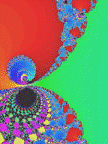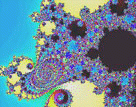Fractals are self-similar objects: the closer you look the more
you see. One result of being self-similar is that fractals can be described
as having a fractional dimension.

A fraction of a dimension? Here is one way to understand this idea.
If you try to measure a non-exotic object, like a watering hose randomly
tossed onto the garden lawn, with a ruler, then the number you get for
the length will depend on the length of the ruler.
A six foot ruler will give only a crude approximation to the length
of the hose. A six inch ruler "flip-walked" along the hose does
a better job.
As you use smaller and smaller rulers you converge on (get closer and
closer to) the actual length of the hose.
With a fractal object, like a coastline, the smaller you make your
ruler, the longer the coastline appears. This is because smaller and smaller
rulers measure smaller and smaller jigs and jags in the coastline. Fractal
objects have jigs and jags on all scales. They do not start to look smooth
as you magnify them.
|
|
In other words, fractals are infinitely complicated: the closer you
look the more detail you see. Most fractals are generated by relatively
simple equations where the results are fed back into the equations again
and again. The recursiveness of this procedure is why one sees structure
at one scale in a fractal repeated, perhaps shrunk, rotated, and slightly
distorted, on another smaller scale.
The mathematician
Benoit Mandelbrot
,
long a student of unusual statistical
processes, coined the name "fractal" in the mid-1970s for this
class of self-similar complicated objects that emerge out of simple recursive
rules.

The procedures that produce fractals can either be probabilistic, like
Michael Barnsley's
Iterated Function Systems
, or determinstic processes
that produce
chaotic attractors
.
|
|
|